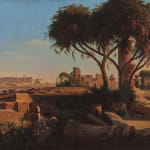


JOHANN JAKOB FREY BASLE 1813 -FRASCATI 1865
Egypt, View of Karnak from the South
Oil on canvas
54 x 104 cm
76,5 x 126 x 8 cm (with the frame)
76,5 x 126 x 8 cm (with the frame)
%3Cdiv%20class%3D%22artist%22%3EJOHANN%20JAKOB%20FREY%3C/div%3E%3Cdiv%20class%3D%22title_and_year%22%3E%3Cspan%20class%3D%22title_and_year_title%22%3EEgypt%2C%20View%20of%20Karnak%20from%20the%20South%3C/span%3E%3C/div%3E%3Cdiv%20class%3D%22medium%22%3EOil%20on%20canvas%3C/div%3E%3Cdiv%20class%3D%22dimensions%22%3E54%20x%20104%20cm%3Cbr/%3E%0A76%2C5%20x%20126%20x%208%20cm%20%28with%20the%20frame%29%3C/div%3E
Literature
K.R. Lepsius, Briefe aus Aegypten Aethiopien der Handlung des Sinai, Berlin 1852
A Swiss landscape artist, born in Basel, Frey studied mainly in Italy. After studying in Munich and Paris, he arrived in Rome between 1835 and 1838, and would stay there until his death, studying first at Palazzo Venezia, the seat of the Austrian Academy in those years, then in Via S. Isidoro, already the abode of the Nazarene artists.
The opportunity to embark on an archaeological mission to Egypt and Ethiopia, led by his friend, the archaeologist Karl Richard Lepsius, arrived from Cavalier Bunsen, the Prussian consul to the Holy See and in turn also an archaeologist, who enlisted him in order to graphically document the locations and finds. Due to health problems, the painter was forced to leave the group after only a few months.
Frey’s experience in Egypt and the studies he made of those places were to prove a source of inspiration for the artist in the coming years when, in his new studio in Via Capo Le Case (Rome), he re-elaborated the sketches and drawings made during his travels, establishing himself as an Orientalist, in contrast to other non-Italian landscape painters who reproposed a Mediterranean iconographic repertoire.
This canvas represents a panoramic view of the monumental complex of Karnak – which together with Luxor constituted ancient Thebes. Distinguished by a particular attention to the minutest detail and by a sound philological precision, the painting describes all the sectors of the fascinating archaeological site dedicated to the Egyptian god Amun: the majestic avenues populated by sphinxes – with heads of rams, an animal sacred to the deity, or with Pharaoh’s heads – the great portal to the city of Ptolemy III Euergetes, the complex of temples dedicated to the Theban Triad (Amon-Ra, Mut and Khonsu) the lake sacred to the god Amun on the right and at the front, the two sacred obelisks.
The particular modulation of the light chosen and the expansive vantage point looking out over the landscape are almost imposed on the architectural elements.
Predictably, his stay in Egypt with the new dominance of the colours, the forms of atmosphere and light, the skies, dawns, and sunsets were impressed on the painter’s retina and drew him to new colour experiences which merged with his background in Munich and his years in Rome in the footsteps of the legacy of the most innovative artists of German culture, until he finally took his inevitable place among the masters of landscape painting.


